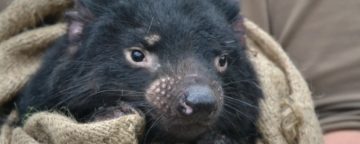Natalia Mesa in The Scientist:
 Tasmanian devil populations have dwindled in recent decades due to two contagious facial cancers that cause debilitating growths. Now, alongside an international group of scientists and organizations, researchers from University of Cambridge conducted a large genetic sequencing study published in Science, and found that one of those cancers is evolving at an alarming pace and may pose a grave threat to Tasmania’s top carnivore.1 This study is the first to track the evolution of the two cancers, creating a detailed account of when the cancers arose, how they spread across the landscape, and importantly, which mutations helped them spread over time.
Tasmanian devil populations have dwindled in recent decades due to two contagious facial cancers that cause debilitating growths. Now, alongside an international group of scientists and organizations, researchers from University of Cambridge conducted a large genetic sequencing study published in Science, and found that one of those cancers is evolving at an alarming pace and may pose a grave threat to Tasmania’s top carnivore.1 This study is the first to track the evolution of the two cancers, creating a detailed account of when the cancers arose, how they spread across the landscape, and importantly, which mutations helped them spread over time.
Carolyn Hogg, a biologist at the University of Sydney who was not involved in the study, said that the research team has generated useful tools to study the devils. “You can make massive headway into understanding how the species [and] disease move through the landscape, and how the disease mutates and changes,” with genomic data, she said.
Devilish diseases
Tasmanian devils are the world’s largest carnivorous marsupials, native to only Tasmania, an island off the coast of southeast Australia. For more than 30 years, these marsupials have been battling two deadly facial cancers, devil facial tumor 1 (DFT1) and devil facial tumor 2 (DFT2). A unique feature of these cancers is that they primarily spread through biting, a common occurrence in devils during fights over mates and food. Transmissible tumors are exceedingly rare in nature, making the devils important models for studying cancer evolution.
More here.
